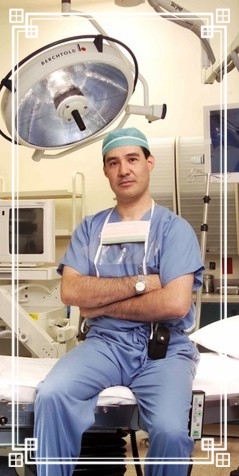Blepharosplasty

BLEPHAROPLASTY or Surgery of the Eyelids
If you’re considering a blepharoplasty...
The main goal of this surgery is to eliminate puffiness and bags under the eyes that make you look worn and tired (“the tired look"), droopy eyelids can make you look older and can also impair vision. Blepharoplasty corrects these problems.
If you’re considering blepharoplasty, this information will help provide a basic understanding of what a blepharoplasty can and cannot achieve. Because facial aging affects each individual patient differently no amount of written information can replace a personal consultation with Dr. Gomez-Mendoza and his team.
The following information is strictly the opinion of Dr. Gomez-Mendoza and pertains to blepharoplasty and other Facelift procedures as performed by him.
What is a blepharoplasty?
Blepharoplasty removes the excess fat, muscle, and skin from both upper and lower lids. The results can be a refreshed appearance, with a younger, firmer eye area.
This procedure cannot alter dark circles, fine lines and wrinkles around the eyes (“crow’s feet”), for that it are necessary to use other procedures.
Dr. Gomez-Mendoza frequently performs Facelift of the eyelids with browlift and limited laser resurfacing or peeling and in some cases even in combination with facelift procedures.
The main goal of a blepharoplasty is to help your face look its best and give you a look of health and more youthful appearance. Sometimes the overall effect will be more successful if additional changes are made in the chin and neck areas through other facial surgery. Many patients decide to have facial liposculpture to remove excess fatty deposits in conjunction with a blepharoplasty. If several flaws need correction, more than one procedure may be necessary for the best overall result.
Where are the incisions for a blepharoplasty?
In upper eyelid surgery, we will first mark the individual lines and creases of the lids in order to keep the scars as invisible as possible along these natural folds. The incision is made, and excess fat, muscle, and/or loose skin are removed. Fine sutures are used to close the incisions, thereby minimizing the visibility of any scar.
In lower eyelid surgery, we will make the incision in an inconspicuous site along the lashline and smile creases of the lower lid. Excess fat, muscle, and skin are trimmed away before the incision is closed. Eyelid puffiness caused primarily by excess fat may be corrected by a transconjunctival blepharoplasty. The incision in this case is made inside the lower eyelid and excess fatty material is removed.
Under normal conditions, blepharoplasty can take from one to two hours.
A certain degree of swelling and bruising is normal. Cold compresses, as well as head elevation when lying down, will enhance healing and relieve discomfort.
For a week and a half following blepharoplasty, you will clean the eye area (the eyes may feel sticky, dry and itchy). Eye-drops will be recommended. The stitches will be removed in three to five days after surgery.
What type of anesthesia is used?
Dr. Gomez-Mendoza performs most blepharoplasty procedures, including transconjunctival blepharoplasty, under sedation some patients refer to this as "twilight" type anesthesia (gentle, short-acting medication is administered by a board certified anesthesiologist to insure comfort and security for our patients) and local anesthesia. Patients are under monitored anesthesia care since they arrive to the operating room till they leave the recovery area; ensuring that you receive the safest care possible. The expert care you deserve.
Our patients recover more quickly and with less discomfort than when general anesthesia is used.
In some cases even the local anesthesia itself may serve as the sole means of anesthesia providing sufficient comfort during the procedure in a cooperative patient.
After the surgery...
It's important for you to keep in mind that healing — of any form — is a gradual process during the initial phases of recovery, you'll experience minor pain and discomfort along with swelling and bruising around the operative areas in some cases. This is normal. You'll be given medications to handle the pain, and in time, the swelling and bruising will disappear. It's also not unusual to feel depressed in the days following surgery. Again, keep in mind that this is normal and will subside as you begin to look and feel better.
Full recovery usually takes five to seven days, most patients go back to work in a week. Scars are usually not noticeable. after enough time has passed for them to mature. In any case, they are easily disguised in a natural skin line .Bear in mind that the aging process continues after surgery and that some relaxation of tissue will occur later. Blepharoplasty is performed as an outpatient procedure, so after recovering for approximately 1-3 hours you will be able to go home or to your hotel room.
Where will your blepharoplasty be performed?
Although Dr. Gomez-Mendoza has been granted staff privileges at most of the local hospitals and outpatient surgery centers, he performs most blepharoplasty procedures at the modern Puerta de Hierro Medical Center. Whether you choose to have your procedure done in the peaceful seclusion of our state-of-the-art Medical Center or an area hospital; rest assured that you'll receive the finest care available.
How do I prepare for my blepharoplasty?
Eyelid surgery must be individualized for each patient; Dr. Gomez-Mendoza will evaluate your face, including your skin, and with your assistance, make recommendations as to the specific procedures that will most likely help you achieve your aesthetic goals. A detailed history of medical conditions that could affect your surgery will be obtained including use of medications, vitamins, etc.
You will be given detailed written instructions on how to prepare for your surgery including guidelines on eating and drinking, smoking, and avoidance of certain vitamins and medications. If you smoke it’s especially important to stop (and also to avoid second-hand smoke) for at least two weeks prior to surgery because of the deleterious effect of smoking upon the healing process. Carefully following these instructions will help your surgery go more smoothly. In addition, we'll also be available to answer any questions you might have or any concerns that arise. Please don't hesitate to call us.
Are there any risks?
When blepharoplasty is performed by a qualified plastic surgeon certified by the Board of Plastic Surgery, complications are infrequent and usually minor.
While Dr. Gomez-Mendoza and his team make every effort to minimize risk, individuals vary greatly in their anatomy, their healing ability as well as in their reactions to surgery and anesthesia. You can reduce your risks by closely following the advice of your surgeon concerning your pre- and post-operative care.
To contact plastic surgeon Dr. Jesús Gómez Mendoza about any cosmetic surgery procedures, please fill out our contact form or call us at +52 (33) 3848-5477
DR. JESÚS CARLOS GÓMEZ MENDOZA
Cirujano Plástico Estético y Reconstructivo UNAM
Ced. Prof. 1380418
Ced. Esp. 3223900
Certificado por CMCPER No. 682
Aviso de publicidad COFEPRIS 213301202A0627
CIRUGIA ESTETICA GUADALAJARA
Tel. (33) 3848-5477
Suite 307-B
Blvd. Puerta de Hierro # 5150
Zapopan, 45116
Horario:
Lunes a viernes
10:00am a 02:00pm
04:00pm a 08:00pm
Sábado
10:00am a 02:00pm
Especialista en Faloplastia, cirugía facial y corporal masculina

LINKS RÁPIDOS:
- Rinoplastia o Cirugia de Nariz
- Faloplastia
- Operacion de orejas o Cirugias de orejas
- Cirugia Estetica de Pantorrillas o implantes de pantorrillas
- Lipoescultura para hombres
- Cirugias Lipoescultura
- Levantamiento de senos
- Cirugia Plastica de Senos
- Lipoescultura laser costo
- Abdominoplastia o Lipectomía
- Liposuccion
- Implantes gluteos
- Lifting facial
- Blefaroplastia o Cirugia de Parpados
- Faloplastia precio
- Faloplastia antes y después















